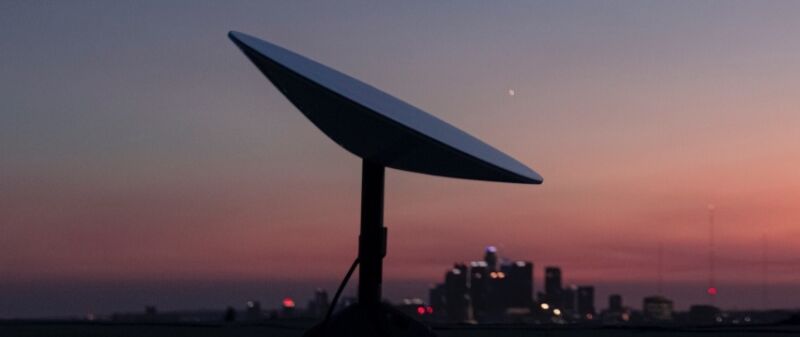
As already mentioned on Habré, the satellite Internet provider Starlink, which is headed by Elon Musk, announced that the number of users had reached 10,000 people. All of them are participants in beta testing of the global satellite network, the basis of which is communications devices in low orbit.
The network characteristics, according to Starlink representatives, should not be lower than 100 Mbps for download, 20 Mbps for upload. The delay is no more than 100 ms. These conditions are spelled out in an agreement with the FCC - the Federal Communications Commission with the United States, jokes with which are fraught with detailed checks of the company's activities. As far as we know, Starlink complies with the terms of service, but the Commission decided to check the quality of the service on its own.
Starlink is doing well
The company continues to launch satellites into orbit, expanding bandwidth and reducing delays. All these indicators should improve in the near future.
The company said that the provider's performance is in compliance with the regulations, and the network specifications, published regularly, are not theoretical. All this is measured in users' homes and corresponds to reality. Latency is even lower than 31ms, which is much better than most US landline and mobile providers.
Recently, 10 satellites equipped with laser communications were sent into orbit to cover the polar regions. In 2022, other Starlink vehicles launched into orbit will be equipped with similar modules.
Lasers enablesatellites keep in touch not only with ground stations, but also with each other, and it does not matter where the "colleague" is located - in the same orbital plane, or in an adjacent one. Accordingly, the operator will be able to minimize the number of ground stations, expanding the coverage area of remote regions where there are no ground stations at all. In addition, latency is reduced as the number of intermediaries between satellites and ground stations decreases.
Currently, the number of satellites of the company in orbit exceeds 1000.
What and why the FCC checks

The fact is that Starlink is deploying the network not only at its own expense. The company recently became one of the largest recipients of the FCC's Rural Digital Opportunity Fund (RDOF) by winning a tender.
The regulator's fund allocated $ 885.51 million to the company. These funds are not allocated immediately, but within 10 years. That is, Starlink will receive $ 88.5 million annually. In 10 years, the number of US households with Internet from SpaceX should be 642,925 in 35 states.
Since the regulator has allocated huge funds, it will check the fulfillment of the terms of the contract very carefully. At the same time, competitors complain about SpaceX. The National Rural Electric Cooperative Association (NRECA) and the National Rural Telecommunications Cooperative (NRTC), for example, have said that the allocation of funds to Starlink and other companies puts the “aspirations of the residents of the regions” at risk of breaking promises.
SpaceX network beta test raises questions from competitors
Groups that compete with Starlink argue that there is no guarantee that the company will deliver what it promised, as its technology has yet to be fully tested. Moreover, the network is not available everywhere.
A competitor said in a statement: “The satellite network is still in beta testing, so communication is not available everywhere, but questions remain. At the same time, the satellite network has not yet demonstrated the combination of speed and latency previously promised by the company. " Well, plus the representatives of the group believe that the allocation of funds to companies that are just testing their technologies is not a justified step on the part of the FCC, especially since SpaceX does not need much funding from the outside.
Moreover, Starlink has been called “just a science experiment,” for which a huge amount of government funds have been allocated. This phrase alone clearly shows how dissatisfied the competitors are with the company and its achievements.
The Free Press consumer advocacy group recently analyzed the results of the auction and found that SpaceX had won funding for a project in locations such as the Jersey City Target store; the "luxury hotel" neighborhoods in Chicago; "Empty parking lots, grassy fields and highways" near Washington, DC; "A garage in downtown Miami Beach, two blocks from the beach, surrounded on all sides by many providers offering gigabit services"; and a street in San Francisco "bordered by the southern edge of Golden Gate Park."
Tender results can be disputed
Starlink received investment support during the presidency of the previous FCC chairman. The new head is unhappy with the way the tender was held. More precisely, the problem is not in SpaceX / Starlink, but in the procedure itself, which, according to the new leader, was carried out incorrectly.
As a result, about $ 16 billion will be allocated over 10 years to the winners of the tender, although for some reason the FCC representatives did not analyze the conditions in which the winners of the tender will work. That is, where is the infrastructure located, what enterprises are around the points of equipment installation, etc.
It is not yet clear if the tender will be canceled or if it will be slightly modified and the projects will be launched as planned. But be that as it may, Starlink is doing well - work continues.
SpaceX few days ago, we managed to successfully carry out the launch of the Falcon 9 rocket with a record number of satellites on board. As a result, 143 satellites will be launched into orbit, this is the largest number of spacecraft launched into orbit at one time in the entire history of astronautics.
Ultimately, the company is going to send 12,000 spacecraft into orbit. And this is only the first stage of the program, after its completion the second starts, according to which there should be another 30 thousand satellites in orbit. The total project cost is $ 10 billion.
